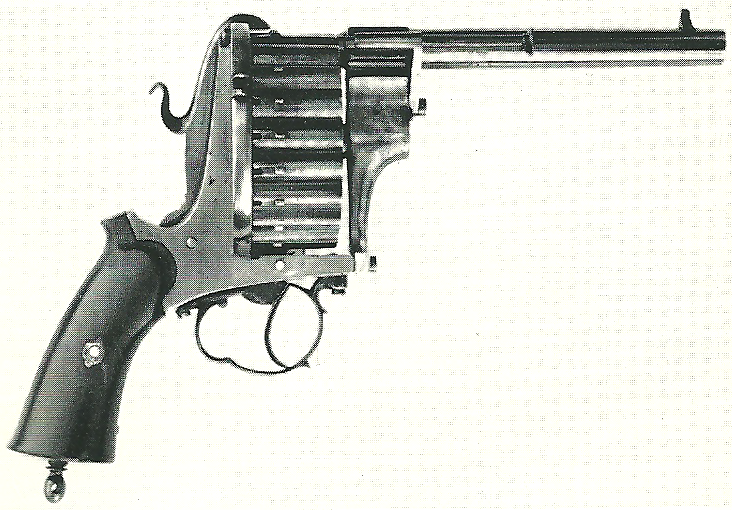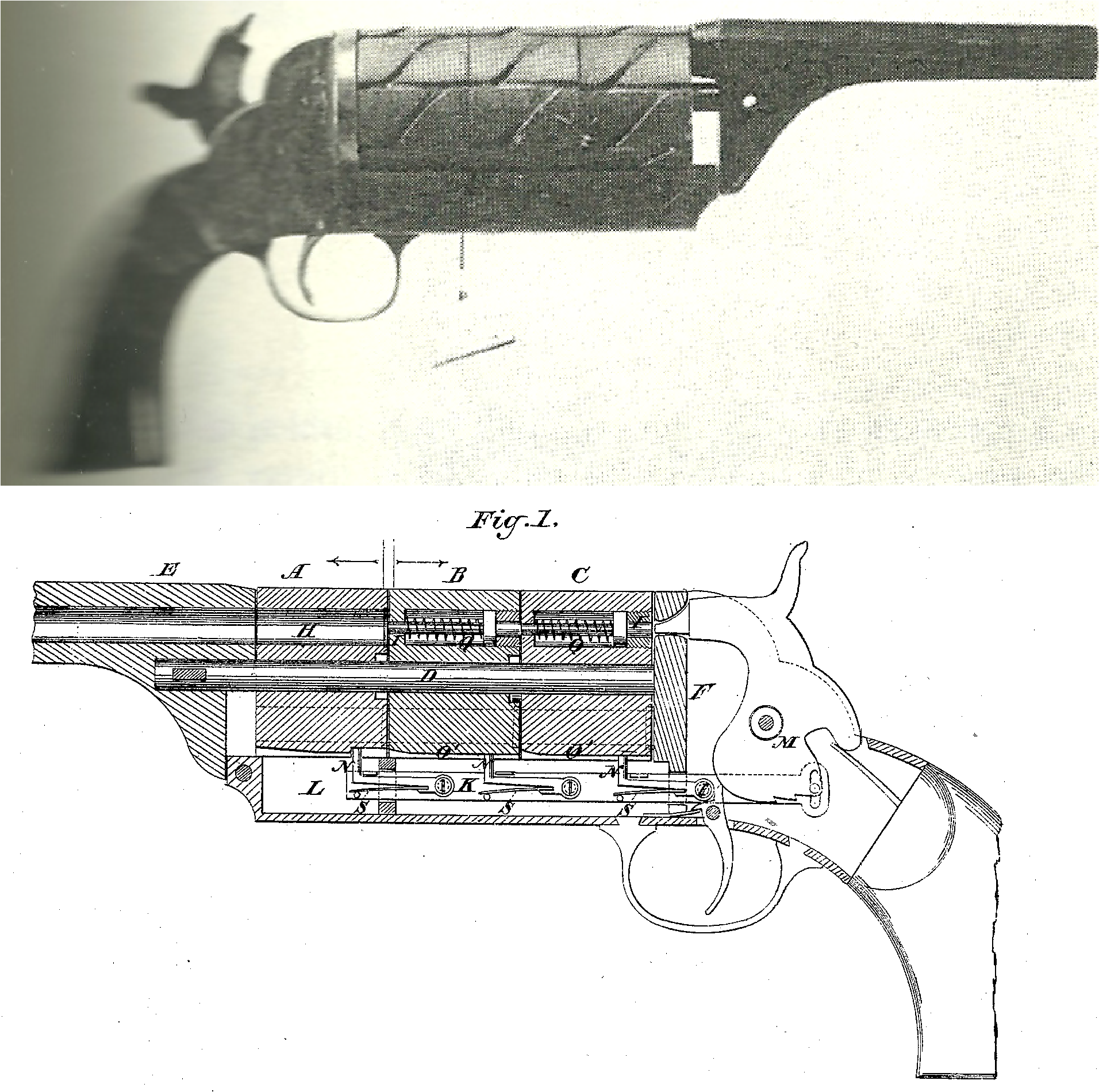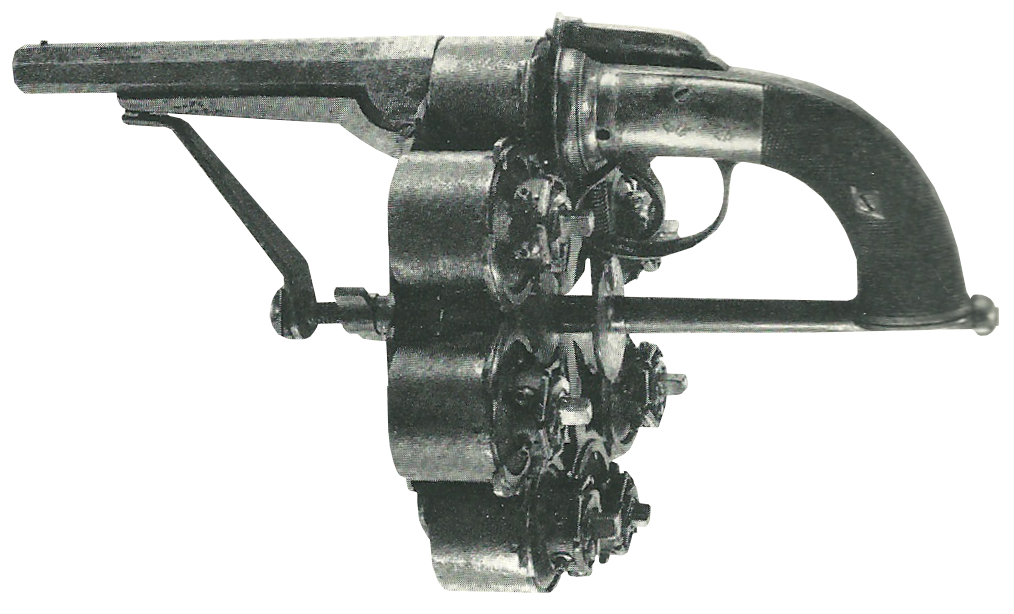Increasing
a revolver's capacity: 19th century techniques
 It is
fair to say that from the mid-late 1800s, there was an obsession amongst
gunsmiths concerning revolvers. This obsession was increasing the number
of shots a revolver can fire. Revolvers could usually only fire about 5 or
6 shots before the weapon had to be reloaded - this was admittedly
preferable to the old flintlock and percussion muzzle-loaders of the early
19th century, which were all single-shot. However, gunsmiths all over the
world still took it upon themselves to design revolvers that could fire
more than six shots, perhaps in the belief that their innovations would
secure them sales. This was rarely the case, and here I will try to
explain the reasons why.
It is
fair to say that from the mid-late 1800s, there was an obsession amongst
gunsmiths concerning revolvers. This obsession was increasing the number
of shots a revolver can fire. Revolvers could usually only fire about 5 or
6 shots before the weapon had to be reloaded - this was admittedly
preferable to the old flintlock and percussion muzzle-loaders of the early
19th century, which were all single-shot. However, gunsmiths all over the
world still took it upon themselves to design revolvers that could fire
more than six shots, perhaps in the belief that their innovations would
secure them sales. This was rarely the case, and here I will try to
explain the reasons why.
Foremost, let's explore the techniques that were used. The most simple
and basic idea that was actually quite commonly deployed was that the
number of shots could be increased simply by increasing the number of
chambers in a cylinder. This was a technically sound plan and led to the
invention of 10- or 12-shot revolvers. Parisian gunmaker Jean Chaineux
used this technique for many of his own designs, including an absurd
20-shot pinfire revolver (pictured). It should be obvious why these
designs weren't hugely popular with customers; they were heavy, unwieldy
and hard to conceal, not to mention time-consuming to place all 20 bullets
in the chambers.
 Another
technique, focused around keeping the cylinder at a reasonable size whilst
increasing the number of chambers within it, can be seen in Dr. Alexandre
Le Mat's revolvers, which employed two seperate barrels. The cylinder had
an outer ring of chambers, which would be discharged from the top barrel,
and an inner ring, which would be discharged from the lower barrel. Each
was chambered for a different bullet. Le Mat's revolver certainly was an
innovation, and it actually gained some popularity in the United States
around the Civil War period. But Le Mat wasn't the only one to try this
technique; Aaron C. Vaughan patented a similar design in 1862. Vaughan's
design saw the two barrels placed almost side-by-side, but the cylinder
system worked in much the same way. Vaughan did not, however, incorporate
two different types of ammunition as Le Mat did. Vaughan's revolver wasn't
very successful, probably because it was about double the thickness of a
Colt percussion revolver.
Another
technique, focused around keeping the cylinder at a reasonable size whilst
increasing the number of chambers within it, can be seen in Dr. Alexandre
Le Mat's revolvers, which employed two seperate barrels. The cylinder had
an outer ring of chambers, which would be discharged from the top barrel,
and an inner ring, which would be discharged from the lower barrel. Each
was chambered for a different bullet. Le Mat's revolver certainly was an
innovation, and it actually gained some popularity in the United States
around the Civil War period. But Le Mat wasn't the only one to try this
technique; Aaron C. Vaughan patented a similar design in 1862. Vaughan's
design saw the two barrels placed almost side-by-side, but the cylinder
system worked in much the same way. Vaughan did not, however, incorporate
two different types of ammunition as Le Mat did. Vaughan's revolver wasn't
very successful, probably because it was about double the thickness of a
Colt percussion revolver.
There were U.S. patents in the 19th century for revolvers with multiple
cylinders. One William H. Philip of Brooklyn designed a centrefire
revolver with 3 cylinders, one in front of the other (pictured right).
Each cylinder had 7 chambers; the first cylinder could be fully loaded
with 7 bullets but the second and third cylinders could only be loaded
with 6 due to the firing mechanism. A spring-loaded needle of sorts passed
through the empty chambers on the second and third cylinders and when the
weapon was fired, the hammer would push the needle would strike the
bullets in the first chamber. Once that chamber was depleted, the needle
would retract back to the second cylinder and the process would
essentially be repeated until it reached the third cylinder. Philip
obtained US patent #142,175 in 1873 for this revolver, and although
physical examples were made, it's not likely that many were sold. Similar
patents were filed by William Orr, Edward Sneider, George Gardiner and
Linberg & Phillips, all of which were dual-cylinder revolvers rather
than triple-cylinder models.
 The
so-called "pepperbox" was a type of percussion-action revolver that was
popular in the mid-19th century. Pepperboxes had rotating cylinders, much
like that of a regular revolver, except they did not have fixed barrels.
Instead, the elongated chambers acted as the barrels. As a result, they
weren't very accurate guns but they were for the most part affordable and
easy to operate. An advantage of the pepperbox design was that they could
have many chambers and still be of a reasonable size, whereas most
conventional revolvers only ever had 5 or 6 chambers. The pepperbox design
led to the advent of the short-lived "transitional" revolvers in England.
The
so-called "pepperbox" was a type of percussion-action revolver that was
popular in the mid-19th century. Pepperboxes had rotating cylinders, much
like that of a regular revolver, except they did not have fixed barrels.
Instead, the elongated chambers acted as the barrels. As a result, they
weren't very accurate guns but they were for the most part affordable and
easy to operate. An advantage of the pepperbox design was that they could
have many chambers and still be of a reasonable size, whereas most
conventional revolvers only ever had 5 or 6 chambers. The pepperbox design
led to the advent of the short-lived "transitional" revolvers in England.
The most bizarre and probably least practical design was made by Joseph
Christian Enouy of Middlesex, who patented a rotating wheel device that
could be fitted on the underside of a transitional revolver (pictured).
The wheel was suspended by a metal axis that ran from the grip to the
barrel. Around the wheel there were eight six-chamber cylinders (48 shots
in total). The idea was that once the firer had discharged all six shots
from one cylinder, they could reload quickly simply by disengaging the
revolver and turning the wheel so that the next cylinder would rotate in
place of the previous one, and so on. Completely unsurprisingly, this
design did not catch on, and it seems to have been Enouy's only venture
into firearms design. I suspect it was a private venture for his own
personal experimentation, as there are no records of his device ever being
sold commercially.
So there you have it. Several 19th century techniques of increasing a
revolver's capacity, none of which have survived the test of time. Today,
most people are quite content with the 6-shot capacity of revolvers; those
who want more firepower are likely to purchase an automatic pistol. That
being said, I have heard of modifications being made to modern revolvers
to replicate these 19th century oddities, but these are done purely out of
experimentation and fun rather than practicality.
Back
to homepage
 It is
fair to say that from the mid-late 1800s, there was an obsession amongst
gunsmiths concerning revolvers. This obsession was increasing the number
of shots a revolver can fire. Revolvers could usually only fire about 5 or
6 shots before the weapon had to be reloaded - this was admittedly
preferable to the old flintlock and percussion muzzle-loaders of the early
19th century, which were all single-shot. However, gunsmiths all over the
world still took it upon themselves to design revolvers that could fire
more than six shots, perhaps in the belief that their innovations would
secure them sales. This was rarely the case, and here I will try to
explain the reasons why.
It is
fair to say that from the mid-late 1800s, there was an obsession amongst
gunsmiths concerning revolvers. This obsession was increasing the number
of shots a revolver can fire. Revolvers could usually only fire about 5 or
6 shots before the weapon had to be reloaded - this was admittedly
preferable to the old flintlock and percussion muzzle-loaders of the early
19th century, which were all single-shot. However, gunsmiths all over the
world still took it upon themselves to design revolvers that could fire
more than six shots, perhaps in the belief that their innovations would
secure them sales. This was rarely the case, and here I will try to
explain the reasons why. Another
technique, focused around keeping the cylinder at a reasonable size whilst
increasing the number of chambers within it, can be seen in Dr. Alexandre
Le Mat's revolvers, which employed two seperate barrels. The cylinder had
an outer ring of chambers, which would be discharged from the top barrel,
and an inner ring, which would be discharged from the lower barrel. Each
was chambered for a different bullet. Le Mat's revolver certainly was an
innovation, and it actually gained some popularity in the United States
around the Civil War period. But Le Mat wasn't the only one to try this
technique; Aaron C. Vaughan patented a similar design in 1862. Vaughan's
design saw the two barrels placed almost side-by-side, but the cylinder
system worked in much the same way. Vaughan did not, however, incorporate
two different types of ammunition as Le Mat did. Vaughan's revolver wasn't
very successful, probably because it was about double the thickness of a
Colt percussion revolver.
Another
technique, focused around keeping the cylinder at a reasonable size whilst
increasing the number of chambers within it, can be seen in Dr. Alexandre
Le Mat's revolvers, which employed two seperate barrels. The cylinder had
an outer ring of chambers, which would be discharged from the top barrel,
and an inner ring, which would be discharged from the lower barrel. Each
was chambered for a different bullet. Le Mat's revolver certainly was an
innovation, and it actually gained some popularity in the United States
around the Civil War period. But Le Mat wasn't the only one to try this
technique; Aaron C. Vaughan patented a similar design in 1862. Vaughan's
design saw the two barrels placed almost side-by-side, but the cylinder
system worked in much the same way. Vaughan did not, however, incorporate
two different types of ammunition as Le Mat did. Vaughan's revolver wasn't
very successful, probably because it was about double the thickness of a
Colt percussion revolver. The
so-called "pepperbox" was a type of percussion-action revolver that was
popular in the mid-19th century. Pepperboxes had rotating cylinders, much
like that of a regular revolver, except they did not have fixed barrels.
Instead, the elongated chambers acted as the barrels. As a result, they
weren't very accurate guns but they were for the most part affordable and
easy to operate. An advantage of the pepperbox design was that they could
have many chambers and still be of a reasonable size, whereas most
conventional revolvers only ever had 5 or 6 chambers. The pepperbox design
led to the advent of the short-lived "transitional" revolvers in England.
The
so-called "pepperbox" was a type of percussion-action revolver that was
popular in the mid-19th century. Pepperboxes had rotating cylinders, much
like that of a regular revolver, except they did not have fixed barrels.
Instead, the elongated chambers acted as the barrels. As a result, they
weren't very accurate guns but they were for the most part affordable and
easy to operate. An advantage of the pepperbox design was that they could
have many chambers and still be of a reasonable size, whereas most
conventional revolvers only ever had 5 or 6 chambers. The pepperbox design
led to the advent of the short-lived "transitional" revolvers in England.